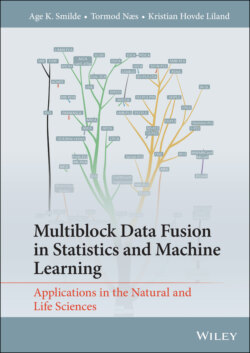Читать книгу Multiblock Data Fusion in Statistics and Machine Learning - Tormod Næs - Страница 10
Preface
ОглавлениеCombining information from two or possibly several blocks of data is gaining increased attention and importance in several areas of science and industry. Typical examples can be found in chemistry, spectroscopy, metabolomics, genomics, systems biology, and sensory science. Many methods and procedures have been proposed and used in practice. The area goes under different names: data integration, data fusion, multiblock analyses, multiset analyses, and others.
This book is an attempt to provide an up-to-date treatment of the most used and important methods within an important branch of the area; namely methods based on so-called components or latent variables. These methods have already obtained enormous attention in, for instance, chemometrics, bioinformatics, machine learning, and sensometrics and have proved to be important both for prediction and interpretation.
The book is primarily a description of methodologies, but most of the methods will be illustrated by examples from the above-mentioned areas. The book is written such that both users of the methods as well as method developers will hopefully find sections of interest. At the end of the book there is a description of a software package developed particularly for the book. This package is freely available in R and covers many of the methods discussed.
To distinguish the different types of methods from each other, the book is divided into five parts. Part I is an introduction and description of preliminary concepts. Part II is the core of the book containing the main unsupervised and supervised methods. Part III deals with more complex structures and, finally, Part IV presents alternative unsupervised and supervised methods. The book ends with Part V discussing the available software.
Our recommendations for reading the book are as follows. A minimum read of the book would involve chapters 1, 2, 3, 5, and 7. Chapters 4, 6 and 8 are more specialized and chapters 9 and 10 contain methods we think are more advanced or less obvious to use. We feel privileged to have so many friendly colleagues who were willing to spend their time on helping us to improve the book by reading separate chapters. We would like to express our thanks to: Rasmus Bro, Margriet Hendriks, Ulf Indahl, Henk Kiers, Ingrid Måge, Federico Marini, Åsmund Rinnan, Rosaria Romano, Lars Erik Solberg, Marieke Timmerman, Oliver Tomic, Johan Westerhuis, and Barry Wise. Of course, the correctness of the final text is fully our responsibility!
Age Smilde, Utrecht, The Netherlands
Tormod Næs, Ås, Norway
Kristian Hovde Liland, Ås, Norway
March 2022
